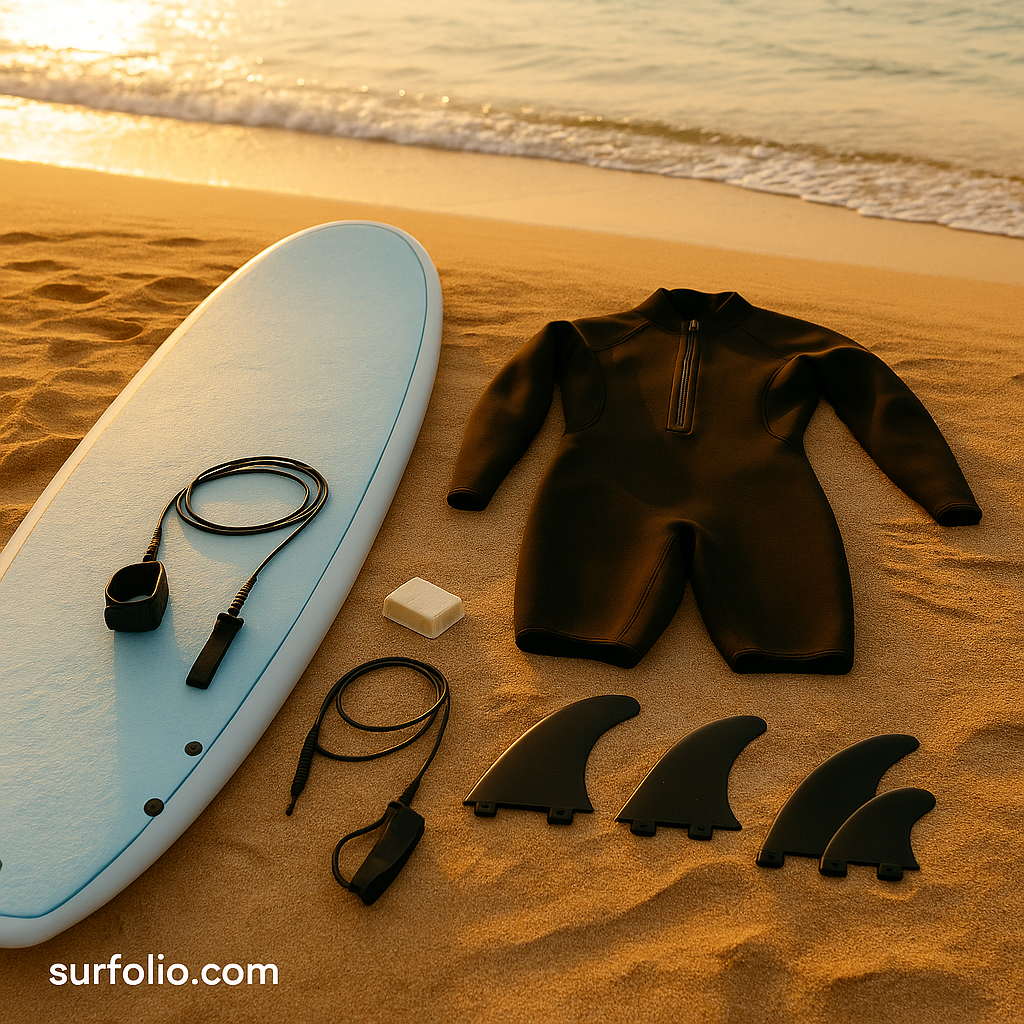
Your First Step Into Surfing
If you’re just beginning your surf journey, the world of gear can feel overwhelming — different board sizes, wetsuit types, and accessories you’ve never heard of.
But here’s the truth: you only need a few essentials to start surfing safely and confidently. Once you have the right setup, every session becomes easier, more comfortable, and way more fun.
1. Surfboard: The Heart of Your Setup
Your board choice will define your learning curve.
Best beginner board:
- Soft-top (foam) surfboard — usually 8–9 feet long
- Provides stability, buoyancy, and safety
- Easier to paddle, catch waves, and balance on
Look for a board with rounded rails and a wide nose. Foam boards are forgiving and perfect for your first 6–12 months in the water.
Pro tip: Start with something that feels “too big.” You’ll catch more waves — and that’s how you progress faster.
2. Wetsuit: Comfort and Warmth
A wetsuit keeps your body warm, flexible, and protected from rashes and UV rays.
Choose thickness based on water temperature:
- Warm water (72°F / 22°C+): Springsuit or rash guard
- Moderate (60–72°F / 16–22°C): 3/2 mm full suit
- Cold (below 60°F / 16°C): 4/3 mm or thicker
Make sure your wetsuit fits snugly — no loose spots or air pockets — but not so tight that it restricts movement.
3. Leash: Your Safety Line
A surf leash connects your ankle to your board, preventing it from floating away after a wipeout.
Choose the right size:
- Leash should be roughly the same length as your board.
- Beginners should use a thicker leash (7–8 mm) for durability.
Always check your leash string and cuff before paddling out — this simple gear can save you (and others) from dangerous situations.
4. Surf Wax: Grip for Your Feet
Wax prevents your feet from slipping on your board’s surface.
How to apply:
- Clean the board.
- Rub in small circles until the deck feels textured and grippy.
- Use base coat (optional) and a top coat suited to your water temperature.
Wax temperature guide:
- Cold water: Soft wax
- Warm water: Harder wax
You can also use a traction pad near the tail for extra grip.
5. Fins: Your Board’s Steering System
Fins give your board direction and stability.
Most beginner boards come with soft plastic fins or removable systems like FCS or Future.
As you progress, experiment with:
- Thruster setups (3 fins) for control and balance.
- Twin fins for a looser, faster feel.
Properly installed fins make a huge difference in how your board turns and holds its line.
6. Board Bag or Sock: Protection Between Sessions
Even small dings or UV damage can shorten your board’s life.
A board bag or sock protects it from heat, scratches, and sun exposure.
If you’re traveling or storing your board in a car, this is a must-have.
7. Sunscreen and Rash Guard
Never underestimate the sun. A reef-safe sunscreen and a rash guard (or surf shirt) protect your skin from UV rays and board friction.
Choose zinc-based formulas and long-sleeve rash guards for full coverage.
8. Optional but Useful Extras
- Ear plugs: Prevent surfer’s ear in cold or windy water.
- Surf hat or cap: Shields your face during long sessions.
- Repair kit: For small dings or cracks in your board.
- Changing towel or poncho: Makes parking lot changes easier.
Beginner Surf Gear Checklist
| Item | Purpose | Beginner Tip |
|---|---|---|
| Foam surfboard | Easy balance | Start with 8–9 ft |
| Wetsuit | Warmth & protection | Fit snug but flexible |
| Leash | Safety | Match board length |
| Wax | Traction | Choose temp-specific |
| Fins | Direction & hold | Start with thruster |
| Board bag | Protection | Avoid heat and UV |
| Sunscreen & rash guard | Skin safety | Always use reef-safe |
Final Thoughts
Surfing doesn’t require expensive gear — just the right gear.
Start with a foam board, a good wetsuit, and basic essentials. As your skills grow, you’ll naturally refine your setup to match your style.
Remember: great surfers aren’t made by fancy equipment — they’re made by time in the water.
Keep it simple, stay consistent, and enjoy the ride.
